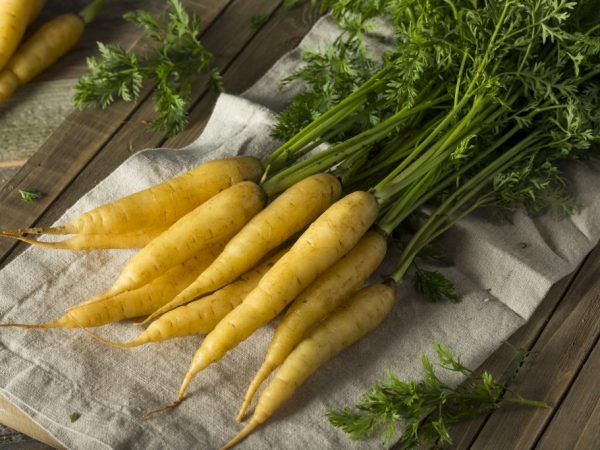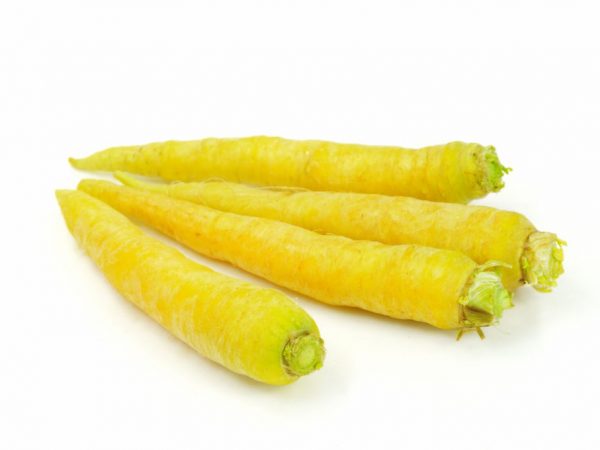Composition of yellow carrots
Carrots were one of the first root crops that people began to domesticate. Now the work on the selection of this vegetable continues. People use varieties of different colors and shades. One of the most widely consumed species in the world is the yellow carrot.

Composition of yellow carrots
Composition of yellow carrots
The color spectrum of the root crop depends on its chemical composition. Yellow carrots, together with the reddish-orange representatives of the varieties, are characterized by a predominance of carotene in the composition. Violet and light pink species are susceptible to the accumulation of substances such as anthocyanins. White carrots have small amounts of these ingredients, but are famous for their high amounts of glucose and dietary fiber.
Yellow carrots, together with representatives of white varieties, first grew in Central and Central Asia, while orange and red types of root crops consider the Mediterranean countries their homeland.
The yellow vegetable has both a pale shade and a rich canary. Yellow carrots are used in the world more often than orange, traditional in Russia. It grows small: up to 4 cm in diameter and up to 25 cm in length.
Features that give carrots a yellow color:
- The presence of xanthophyll. This substance is similar in structure and characteristics to carotene. Its high amount gives the roots a yellow tint and a sweet taste. This substance is capable of limiting and stopping the growth of pathogenic cancer cells, for which it is revered by scientists around the world.
- The concentration of lutein in carrots also turns the vegetable bright and sunny. Lutein acts on the human body as a prophylactic agent against cardiovascular diseases. It also has a positive effect on the retina of the eye, protecting against the harmful effects of bright sunlight.
The yellow varieties of carrots contain many vitamins, micro- and macroelements, among which there are vitamins of groups A, B, E, K, PP, H, C, as well as potassium, phosphorus, iodine, iron, zinc, fluorine and magnesium.
Vegetable water inside the root crop is of great value. Its amount depends on the region: the hotter the climate, the drier the vegetable tastes. The sugar content in the composition of yellow carrots is average - up to 7% of the total mass, but it contains a lot of fiber and carotene compounds - up to 70%.
Useful properties of varieties
Yellow carrot varieties are extremely healthy to eat. In the modern world, fodder species intended for agricultural livestock are grown. They are characterized by a higher starch and green mass content.
There are cultural hybrids for consumption: Mellow Yellow F1, Yellowstone, Mirzoi 304, Solar Yellow. They have less juice and glucose in their composition than representatives of the brighter varieties. They are also less caloric - up to 33 kcal per 100 g of product. This allows the vegetable to be used in dietary meals.
Yellow carrots have many health benefits:
- Regular use of yellow carrot juice allows you to get rid of worms, especially effective on the child's body.Also, the juice has the maximum amount of carotene and xanthophyll, which fight cancer and improve the condition of the skin, nails and hair. Carrot juice replenishes the supply of nutrients during periods of vitamin deficiency in the body.
- The components of yellow carrots have a positive effect on the metabolic systems of the human body. They have a choleretic and diuretic effect, and therefore are included in drugs that are taken for urolithiasis and problems with the bile ducts. Also, the yellow variety is used to improve the functioning of the heart and the contractile functions of blood vessels. Root seeds are rich in essential oils.
- Carotene is used as an additive in cosmetics that improve skin color and increase the brightness of hair color. It is even added to special food for ginger breeds of cats and dogs, the use of which by animals allows them to maintain a good condition of the coat and the gastrointestinal tract, not to lose color characteristics. The crunchy properties of the root vegetable also depend on carotene, and regular consumption of raw vegetables by children helps to form a healthy bite and strong enamel.
The negative effects of yellow carrots

Carrots are contraindicated in diseases of the gastrointestinal tract.
Contraindications are tied to a large number of carotene compounds in the composition of the root crop. If a person consumes a large amount of the product within a short time, his skin will acquire a noticeable yellowish tint, especially in the area of the face and palms.
Such external signs are manifested by the disease carotenemia - a supersaturation of the human body with beta-carotene. To get rid of such a misfortune, you should exclude yellow carrots from the diet for 2-3 weeks and monitor the further dose of its use.
Carrots can harm people who have some health problems:
- smoke a large number of cigarettes a day;
- are prone to root vegetable allergies;
- have a stomach ulcer or thyroid problems;
- suffer from insulin-dependent diabetes mellitus.
The risk zone is products grown in large fields. For the convenience of processing and preserving the harvest, insecticides and growth accelerators are often used. The remains of these chemical compounds accumulate in root crops and negatively affect the person who eats them. It is better to opt for organic products grown using organic fertilizers and pest control products.
Using
Yellow carrots are popular in Asia and Europe. It is a component for preparing first and second courses, salads, side dishes and even desserts.
Some cooking rules help to complement the daily and holiday menu:
- meat is often served with a side dish of small carrots fried in a large amount of oil until golden brown;
- fish dishes are successfully complemented by boiled or half-cooked carrots, cut lengthwise or across in circles;
- borscht and soups will be complemented by a dressing of finely grated vegetable, lightly fried in oil;
- real Uzbek pilaf is prepared with the use of equal amounts of orange and yellow carrots, therefore the latter is often called Uzbek;
- small root vegetables are added to seaming and pickles, sometimes with green forelocks to enhance the taste and aroma;
- raw grated carrots with any fat will be a pleasant addition to a vitamin salad;
- finely grated carrots with cream, sour cream or butter, lightly sautéed and with added sugar are used in baked goods, pies, fruit desserts, even in jam.
Conclusion
Yellow carrots contain xanthophyll and lutein, which give them their color. The qualities and composition of nutrients allow the product to be used in the daily diet of a person who does not have any special health problems.


